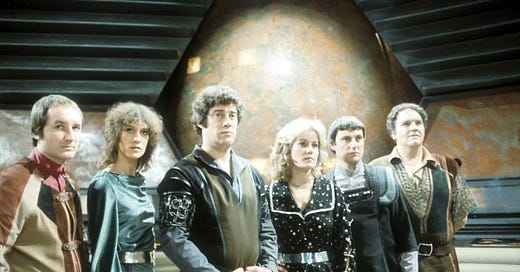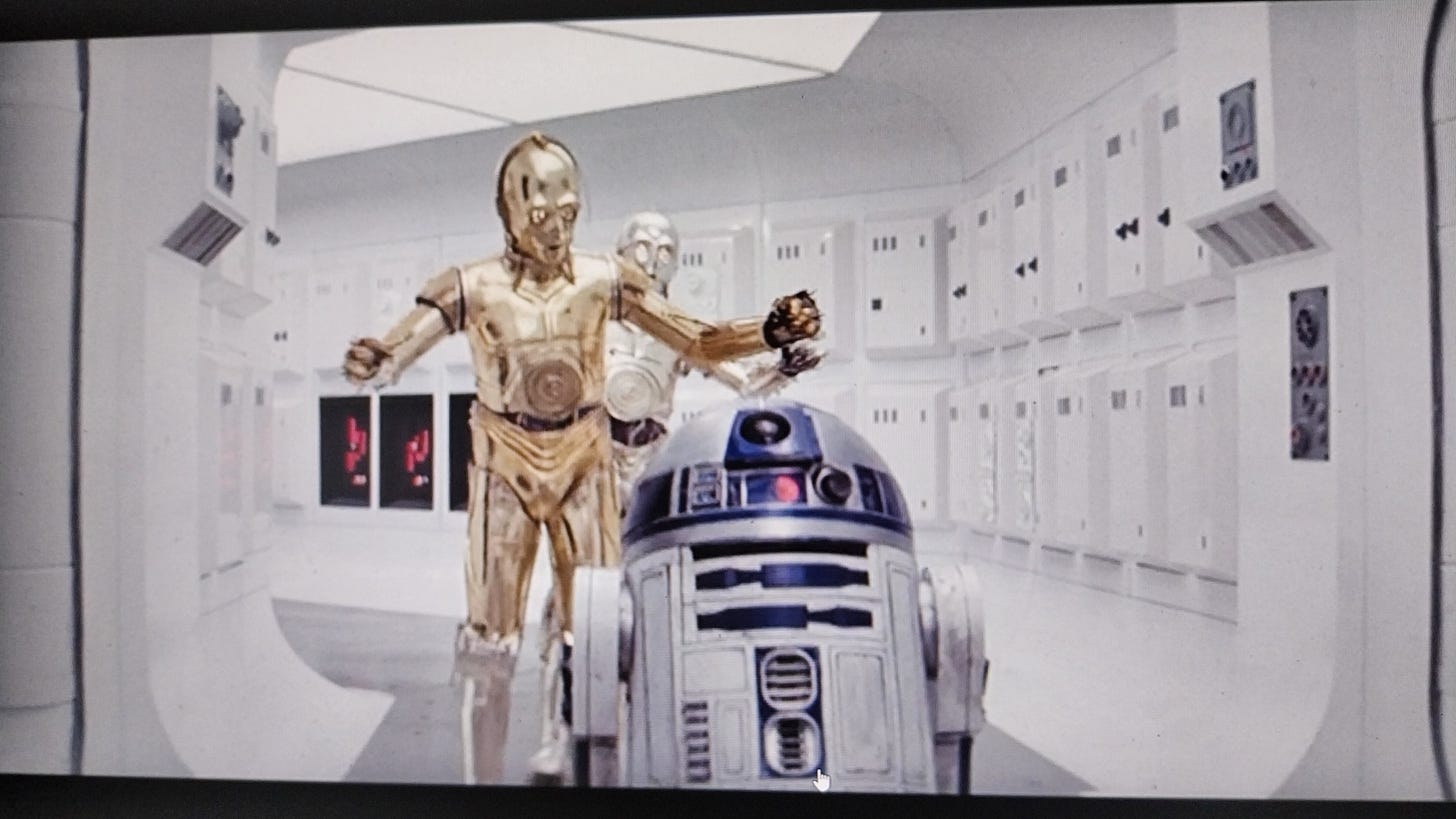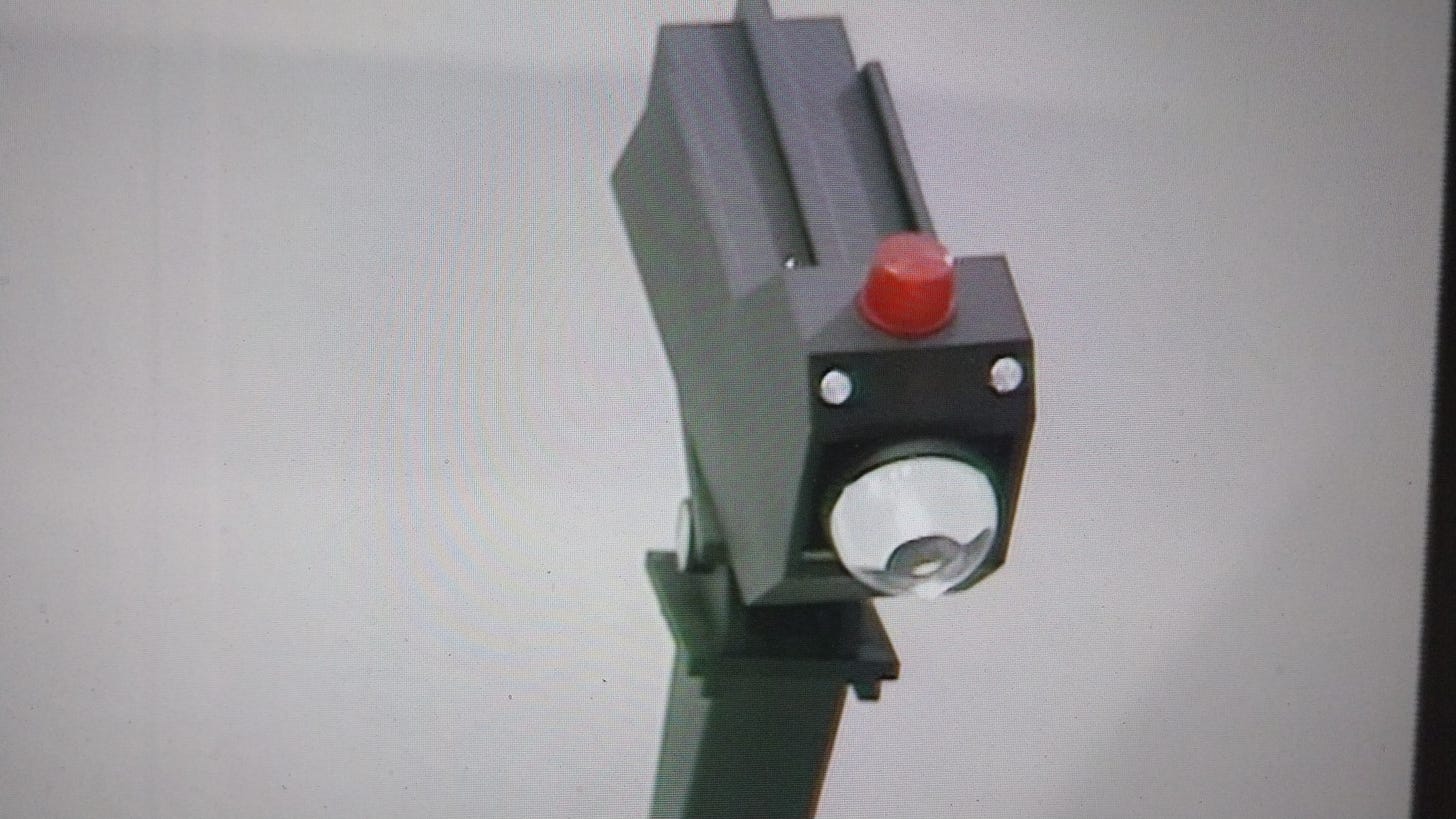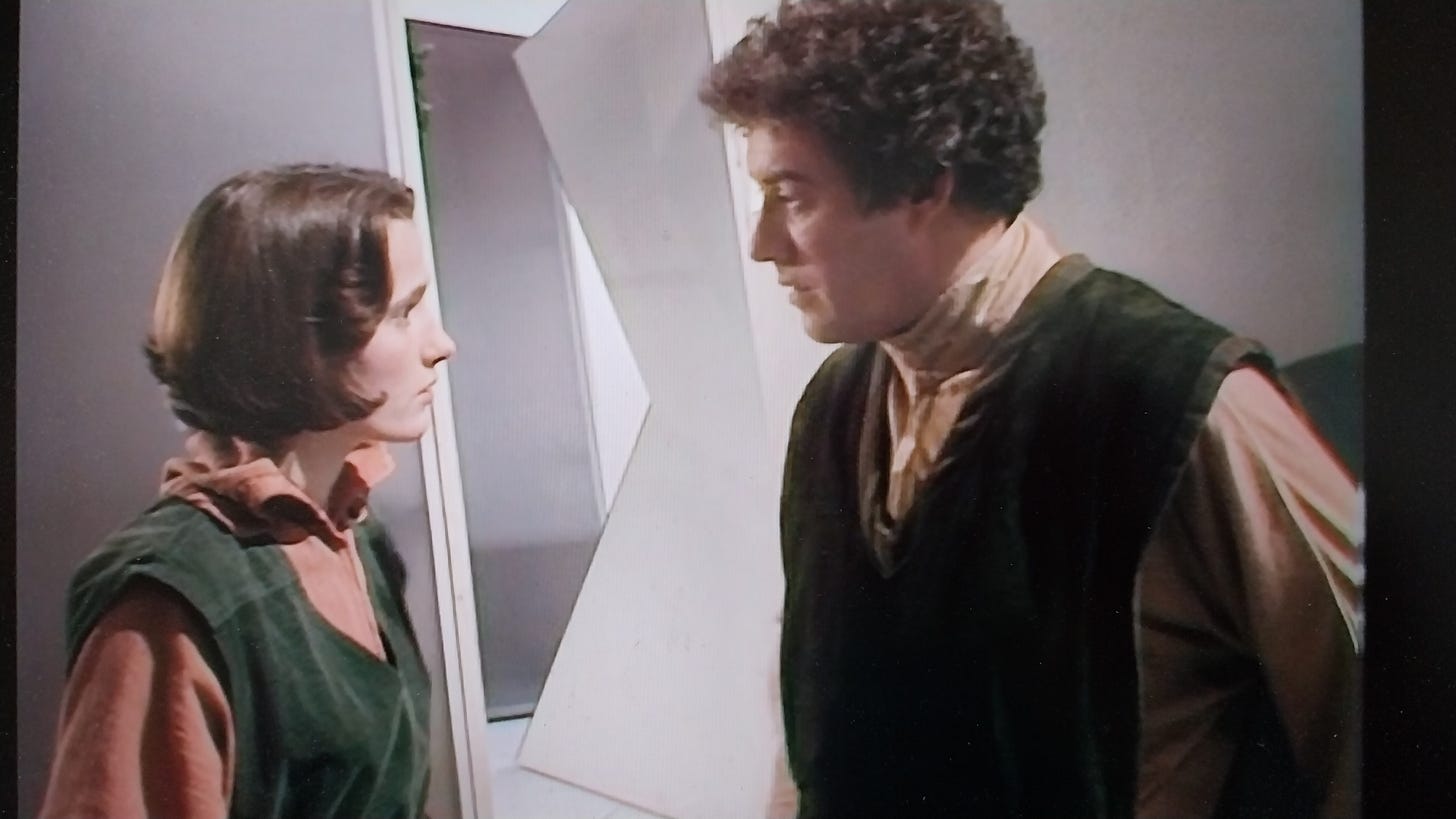“Blake and six of the seven” as the Radio Times put it at the time. L-R Vila (Michael Keating), Cally (Jan Chappell), Blake (Gareth Thomas), Jenna (Sally Knyvette), Avon (Paul Darrow), Gan (David Jackson)
On December 27th, 1977, while the nation groaned under the weight of a hundred million turkey and stuffing sandwiches in a post-Xmas fug of farts and beer fumes, an unparallelled cultural event occured.
After months of hype, a long-awaited science-fiction film was finally released in the UK, where much of it had been filmed.
Star Wars: A New Hope was an instant success, changing the emphasis of the film industry overnight and spawning multiple sequels, TV shows and toys, and, later, at least one religion, many internet memes and many, many internet fights.
It had a beautiful, expensive and entirely convincing look to it.
The opening scene of “Star Wars: A New Hope”. No expense spared.
Five days later, the first episode of the BBC’s new adult science fiction serial Blakes 7 aired. While Star Wars: A New Hope had a budget of $11,000,000, Blakes 7 had to make do with the same budget as the earthbound cop show it replaced in the schedules.1
It was always going to lose out on any comparison on looks alone.
A security camera from the opening scene of “Blake’s 7”. No expense spent.
Downbeat sci-fi was a popular theme on British TV in the 1970s. The BBC had made Survivors a couple of years earlier, a bleak look at a world whose human population had been shrunk massively by a worldwide plague, and a depressingly believable guess at what sort of society might replace the previous one. 2
And in the early 70s there had been Doomwatch, not so much “monster of the week” as “horribly believable existential threat to humanity’s continued existence of the week”, warning against the indiscriminate development of technology and the development of drugs that meddle with the human genome. A kind of adult Doctor Who, only without a benevolent God-like alien to save the day.
Created by Dalek-daddy Terry Nation, Blakes 7 managed a healthy four-year, fifty-two episode run. A cynical, pessimistic view of the future, with the lead characters constantly at odds with each other.
Where the original Star Trek series imagined what might be possible if we were all to work together for the common good, Blakes 7 is a chilling vision of what the future will in all probability hold if we allow the bad people to continue leading us. And let’s be honest, we are now fifty years closer to it.
The first episode The Way Back was shown at 6pm on Bank Holiday Monday, January 2nd, 1978, just after a Tom and Jerry cartoon and just before an John Wayne film.
The early time-slot for this episode is a bit of an eyebrow-raiser given some of the subject matter.
Ravella: (Gillian Bailey) - “All our food and drink is treated with suppressants. Going without for a day and a half, they should be wearing off”
Roj - “Not that again!”
Mild-mannered Roj Blake is disturbed by the seeming rebellious tendencies of his conspiracy theorist friend Ravella, but when she and her other half Dal ask him to accompany them to the forbidden “outside” the Dome where they all live (shades of Logan’s Run), he is intrigued.
When he hesitates, Ravella gives him a nudge by warning him in no uncertain terms that he will be implicated if he turns back now and reports them to the authorities.
Unknown to the three, they are followed by the mysterious Dev Tarrant.
Outside the Dome, Ravella and Dal introduce Roj to Bran Foster, leader of a resistance cell, who tells Roj that he and Bran were leaders of the Resistance against the fascistic Federation, and that Roj’s brother and sister are in fact dead, the vistapes he receives from them “twice a year” being fakes.
Furthermore, Blake was captured by the Federation but rather than execute him and create a martyr, they reprogrammed his brain and forced him to issue statements recanting his previous activities and showing his solid support of the Federation. The propaganda victory is far more important to them than simply doing away with him.
This shows how confident the Federation are that Blake is no longer a threat to them - no longer Blake at all, in fact. Spoiler alert - more fool them…
Roj still has no genuine memory of all this, although he can see the truth in what Bran says. To facilitate against any hesitation, and to speed things up, Bran informs him that he has left incriminating messages in his handwriting back in the dome, making it impossible for Roj to say no to joining the Resistance.
Roj goes off alone in order to take all this in. While he is away, the resistance cell are raided, tipped off by Tarrant. He panics and hides as the group are slaughtered by the Federation police.
When they have gone, Roj comes out of hiding and looks on the scene in horror. He now knows who he is and what he has to do.
Considering that everything so far is just building up to the raison d’etre of the rest of the show’s run, this first act of the show is a masterpiece. It plays like a classic Philip K Dick story.
At the time, I honestly never realised Terry Nation had it in him.
On returning to the Dome, Roj is arrested by the authorities. He tells them everything he witnessed, in a devastatingly naive display of faith that the legal process will vindicate him.
Realising the former rebel is close to breaking his brainwashing and becoming a potential danger to the Federation once again, the authorities try psychotherapy by gaslight.
Doctor - We must try to unravel this fantasy.
Roj - It is not a fantasy!
Doctor - Of course it isn’t.
Roj - Do you believe me?
Doctor - To you it is not a fantasy. Reality is a dangerous concept. Each one of us interprets it in a slightly different way.
…
Doctor - All right then. No drugs. But try not to think any more. Don’t worry. We’ll get it sorted out…
Unfortunately for Roj, “getting it sorted out” means implanting fake memories in three children and staging a trial whose outcome is, of course, inevitable.3 Roj’s defence counsel discovers too late the process of implanting fake facts in someone’s mind was “perfected years ago but prohibited by the medical profession”.
The final scene on the spaceship as it blasts off is a powerful one.
Roj, painfully restrained in his seat as punishment for an invented infraction, twists to looks out of the window, straining for a glimpse of Earth.
The prison guard smiles sadistically.
Guard - “Take a long look, That’s the last you’ll ever see of it”
Blake - “No, I’m coming back”
He says it quietly, without anger, purely as a statement of fact.
The episode is one hell of an intro to the main hero of the series, beaten and humiliated, disgraced as a kiddy-fiddler, entirely without power, framed and sent to a penal colony on Cygnus Alpha, and yet to do anything even remotely heroic.
As far as most people in the Federation are concerned, Blake is now a convicted criminal, and the offences he has been found guilty of are beyond the pale of morality. He is about to be imprisoned for life with no way to communicate the truth to the world - and even if he did, people would no longer trust him.
Not a bad way of neutralising criticism.
The entire series of Blakes 7 is available on itvX in the UK.
Softly, Softly: Task Force, a spinoff from Z Cars. Don’t worry if you’ve never heard of it, you’re not missing much. There is a limit to the programmes of my childhood I get nostalgic about, and this is it.
For a start, judging by the casting, the plague may have done for 99.9% of all humanity, but if you considered non-white people, the figure was actually 100%.
The statements are verified by a lie detector, which are notoriously unreliable, and clearly remain so in the future otherwise they would have exonerated the defendant.








My favourite TV show, even though I met it 40 years later.
It got me out of a rut, helped me find a like-minded community and spurred me to write.
I've just finished rewatching this show. I would love to see a reboot with decent sets and special effects!